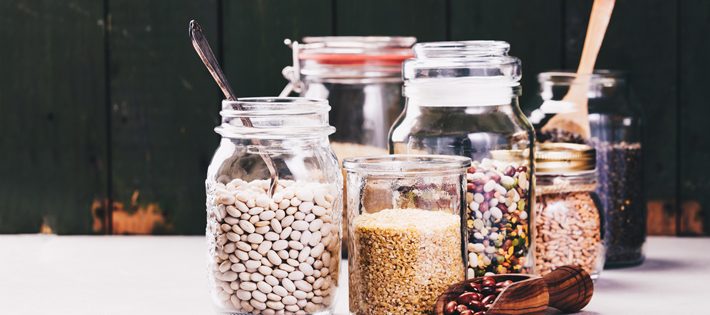Lectins are protein like compounds found in many of the foods we eat including fresh fruit and vegetables. In nature, lectins in the seeds of plants are an important defense against microorganisms, pests, and insects.
Lectins pass through the gut undigested, whether you are an animal eating seeds or a human eating grains and beans. The problem is they are edible enemies, causing damage to the gut lining allowing proteins to enter the bloodstream. Lectins, literally are like superglue affecting the stickiness of blood and impacting on the gut, immune system and other organs.
Toxic to the body.
Lectins can create a toxic load on the body in many ways:
- Resistant to enzymes and stomach acid so they pass through the body undigested creating bloating, diarrhea, pain and cramps.
- The body produces antibodies to lectins triggering the immune system and the possibility of skin rashes, joint pain, and general inflammation.
- Damage the lining of the gut leading to leaky gut making it an ineffective barrier to other foods, bacteria and viruses.
- Chronic gut disorders like IBS and inflammatory bowel disease.
- Reduces absorption of vitamins and minerals.
- Different lectins target different organs and body systems making it hard to work out the cause of the problem.
What foods contain lectins?
- GMO foods. Scientists artificially splice lectins into foods to promote certain traits like pest or fungal resistance. As labelling laws are poor around GMO ingredients in processed foods in Australia, stay away from any corn, soy, canola, cottonseed oil and choose more GMO free and organic foods.
- Fruits and vegetables that are out of season and unripe have a much higher lectin content. Aim to try and eat only produce that is grown locally, sustainably and in season preferably at your local farmers market.
- Legumes and pulses—adzuki, borlotti, chickpeas, fava, kidney beans, soybeans, lentils and peanuts.
- Grains—wheat, rye, oat and rice especially GMO versions of these.
- Nightshade plant family—potatoes, tomatoes, eggplant and capsiscum.
- Cucurbit family—cucumbers and melons.
- Fermenting. The fermentation process like the one used to create Fermented Hemp+ and the range of Probiotic Foods, uses beneficial bacteria to break down foods that might be difficult to digest. Fermented Hemp+ and Gluten and Fructose Intolerant Probiotic Foods blend contain certified organic and non GMO ingredients that are naturally low in lectins. The healthiest cultures in the world eat fermented soy products like miso, tempeh, tamari and natto, sauerkraut and kimchi. Cultures with a history of eating grains traditionally used some form of fermentation. That’s why sourdough bread and sprouted Essene breads are some of the healthiest ways to eat grains for those who are able to tolerate wheat, spelt or rye.
- Cooking and soaking. Even wonder why people bothered with the long soak, rinse and boil session when preparing beans and grains? Lectin reduction. This is probably the most classic method of preparing beans and grains. Adding sodium bicarbonate (a.k.a. baking soda) to the soaking water may help neutralise the lectins further.
- Sprouting. Sprouting seeds, grains or beans decreases the lectin content. Generally, the longer the duration of sprouting, the more lectins are deactivated. In some cases the lectin activity is enhanced by sprouting (like alfalfa sprouts). The lectins in some grains and beans are in the seed coat. As it germinates, the coat is metabolized, eliminating lectins.
Help
If you are concerned about lectins, look at where they might be creeping into your diet especially in the form of grains and GMO foods and gradually start to reduce the amount you eat. Replace grains with sweet potato or pumpkin. If you know your blood type then see if a blood type specific diet helps some of your symptoms. If you like eating beans and lentils but feel the after affects of bloating and gas use a pinch of digestive spices like cumin, coriander, fennel and ginger and sprinkle Probiotic Foods Fermented Hemp+ on your meal. Fill out our 30 day Self-Check Questionnaire to see if you notice any difference on a low lectin diet especially when you eat in season.
DISCLAIMER: This blog provides general information and discussion about gut health and related subjects. Whilst every effort is made to present up to date information, the area of gut health and the microbiome are changing constantly. We welcome any comments or suggestions. By reading this blog, you agree not to use this blog as a substitute for medical advice to treat any medical condition in either yourself or others. The author encourages you to consult a health professional before making any health changes, especially any changes related to a specific diagnosis or condition. No information contained in these pages should be relied upon to determine diet, make a medical diagnosis, or determine treatment for a medical condition. The information is not intended to replace a one-on-one relationship with a qualified healthcare professional and is not intended as medical advice. Links to other (third party) websites are provided to you to expand understanding of the subject and are not an endorsement or recommendation by the author for the services, information, opinion or any other content on the site or as an indication of any affiliation, sponsorship or endorsement of such third party websites. Your use of other websites is subject to the terms of use for such sites. By reading this blog, you agree that you are responsible for your own health decisions. NO information contained in this blog should be used to diagnose, treat, prevent or cure any disease or condition.The contents of these blogs are copyright and Probiotic Foods is the acknowledged author.


